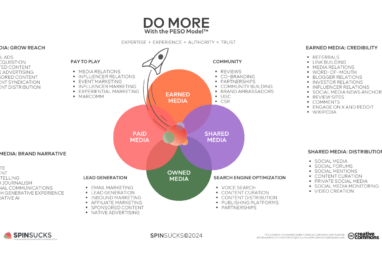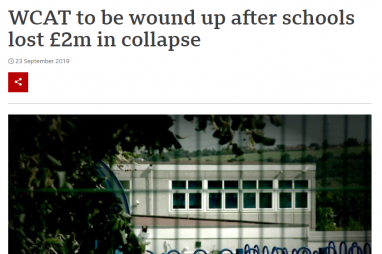The evolution of charity sector comms
About the author
Our guest authors are what make PR Place such a vibrant hub of information, exploration and learning.

Guest author Rachel Sacks shares a piece written as a CIPR Professional PR Diploma thought leadership assignment.

Rachel Sacks
The evolution of communications in the charity sector: from ‘valued’ to ‘strategic’
‘Communications is the biggest challenge faced by the charity sector’ wrote Dame Suzi Leather, the then chair of the Charity Commission, in a Guardian article in 2006. Fast forward twelve years and it’s time to ask ourselves, have we [the charity sector] risen to the challenge? Is the potential value of communications in the charity sector truly being realised?
In 2014, eight years after Suzi Leather’s article was published, Vicky Browning, director of CharityComms, predicted that communications and PR will become increasingly recognised, not just for allowing charities to talk about the changes they make, but how they make change happen. She felt that communications was still sometimes seen as ‘nice-to-have’ or the ‘icing on the cake’.
Today, there seems little doubt that communications and PR are valued more within the not-for-profit sector than they were a decade ago. But this is impossible to prove without first understanding how the ‘value’ of PR and communications is defined in the charity sector, particularly by those who work in it.
According to the CIPR Fifth Estate ‘Get Heard’ Report the two most important factors to those working in charity PR were the attitudes of the CEO and the budget available for PR. Both of these criteria are relatively easily measured, and form a central element of the CharityComms Benchmark Report, which sets out to investigate how our sector has evolved over the last 10 years, and what might lie in the future.
Last year’s report directly addressed questions around the value of communications in the charity – and there was a lot to be positive about.
CharityComms found that communications is now valued by (UK) charities more than it has been at any point over the last decade. Clearly, we’ve come a long way. According to the report, 70% of charities now have someone responsible for communications at executive board level. The average time charity CEOs devote to communications each week has risen year on year, and the average charity budget for non-salary communications continues to rise. Additionally, communications teams themselves have grown from an average team of 6 people in 2009, to 8 in 2017.
You could be forgiven for thinking that our work is done, and communications is edging closer to achieving its full potential within the not-for-profit sector. But unfortunately this isn’t the case.
Whilst these changes are certainly reassuring and clearly show that communications is becoming increasingly valued, the report also revealed a number of concerns felt by, and challenges faced by, people working in charity communications.
The report identified the biggest challenge as being the presence of too many competing priorities. Half of respondents felt that having so many competing priorities is stopping them from reaching their goals. This brings into question the formal process of planning undertaken by charity leaders, and the integration and alignment of communications with organisational strategy. Any functional PR plan should detail purpose, resource and crucially – priorities. So where exactly is the sector being tripped up?
One possibility is that the issue is caused by a cultural attitude towards PR and communications, which the sector hasn’t yet shaken off. It’s the perception that the PR function solely exists to serve the rest of the organisation’s needs. This originates from a lack of acceptance or understanding from some teams that PR is a strategic function which should be aligned to organisation-wide priorities.
As a result some teams and individuals may not accept that what might feel like a priority to them, isn’t necessarily a priority for PR. Having these conversations can be difficult but are absolutely necessary, not only for time and workload management, but for truly successful, strategic PR.
This brings us to the second of the top five problems identified in the report. ‘Integrated communications’ is the buzzword – or rather the buzzphrase – in the charity PR sector this year. Everyone’s talking about it, most people say they are doing it and those who aren’t say they are trying to do it (whilst some probably don’t really know what ‘it’ truly is…).
In fact, better integration was one of Vicky Browning’s predictions for the charity sector over the next 10 years. The CharityComms report found that 45% of charity communications professionals reported a lack of integrated thinking and processes in their organisations. Again, we must look to strategy and organisational culture for answers.
Interestingly, 27% of charity communications professionals felt that there was a poor or non-existent organisational strategy. This leaves a wide gap between those who questioned their communications team’s ability to prioritise (50%), their ability to work in an integrated fashion (45%), and a lack of understanding of communications by others in the organisation. The gap between these numbers is important. Does the issue stem from a lack of communications focus in the wider organisational strategy or does it originate at the point of PR strategy development? In all likelihood, it’s a bit of both.
CharityComms concluded that the top 5 problems highlighted in their report formed an interesting cycle [Fig 1]. Without clear strategy, the cycle is unbreakable. Meanwhile, 31% of respondents said that clearer strategy would make their communications more successful, and ‘strategy’ was the second most mentioned word (after ‘communications’ – obviously). The findings suggest that investment in strategy is the answer to many communications professionals’ problems, which would also reduce stress for staff and provide clarity around priorities and communications objectives.

Figure 1: The cycle formed by the top 5 problems highlighted in the CharityComms report
So where to start when it comes to strategic PR? Firstly, it’s important to get senior ‘buy in’ and commitment to the time and resources needed to produce and commit to an effective PR strategy. If the CharityComms Benchmarking report is anything to go by, that shouldn’t be too difficult.
CEOs are more bought in to communications than ever before, there is increasing communications presence and responsibility in senior leadership and at board level, and budgets are increasing. But we mustn’t get complacent: demonstrating the value of PR to senior management, and the rest of the organisation is crucial.
Next we need to understand what it is that makes public relations strategic.
According to Webster1: “To be strategic, Public Relations must pass one basic test: at a minimum everything that is done must be aligned with the corporate vision or mission (the company’s reason for being) and must substantially contribute to achieving the organisation’s objectives.”
PR aspires to be seen as a strategic management function, comparable to functions such as marketing, fundraising and human resources. It should feed into and be included within organisational strategy, and it should play an important role in delivering that strategy. There are numerous different approaches and techniques which can be used to map out strategic public relations, but the four-by-four model is a great place to start.
The model was developed by Anne Gregory and Paul Willis2, and is essentially a tactical framework for PR strategy development. Cleverly, the four-by-four model highlights the importance of communications in the context of a complex stakeholder environment – crucial given the wide variety of stakeholders often associated with charities.
The four-by-four was originally developed for the NHS (the world’s fourth largest organisation), but it can also be applied to private, public and not-for-profit sectors. According to Gregory, these sectors have more in common than they do differences – which perhaps strengthens the argument that charities have no excuse to approach PR in a different or less strategic manner than their private counterparts. In fact, in the UK most PR and communication practitioners work in the public and third sectors, so the onus is on us to do it right.
PR is seen as a communications function as opposed to a management function, according to esteemed academic James Grunig. This would suggest that the issue of PR not being recognised as a management function is not restricted to the charity and public sector.
The CIPR’s State of the Profession Report 2018 supports this theory, having found that more senior PR practitioners spend the majority of their time copywriting (71%) or working on campaigns (69%), compared with those who spend the majority of their time undertaking strategic planning (66%).
The report also found that under-representation of PR practitioners at board level is the biggest challenge facing the industry, in line with the concerns felt by charity communications professionals.
We can look to the third sector for examples of PR campaigns which help to shift perceptions. PR-led campaigns which help an organisation to reach key objectives contribute to ‘making change happen, as opposed to talking about the changes they make’.
NHS Blood and Transplant’s award-winning Missing Type campaign is probably one of the most widely talked about PR campaigns in the third sector, and for good reason. It’s a great example of a campaign which directly contributed to NHS Blood and Transplant’s objective of recruiting new donors. This directly led to over 30,000 new donors registering during National Blood Week, which was triple the numbers from the same week a year earlier. The campaign also reached a phenomenal number of people through media relations, social media and clever stunts involving removal of the letters A and O from names and logos of organisations for the week.
Of course, most organisations don’t have the budget or resource to carry out a campaign of this scale. However the purpose and execution of the campaign serve as a helpful reminder of what can be achieved when PR is recognised, valued, and aligned with an organisation’s strategy.
We must remember that tactical execution of campaigns such as the Missing Type campaign should take place in the setting of an organisation which has PR at the centre of its strategy. Strategy is bigger than individual campaigns, but the reliability and success of PR campaigns should be underpinned by a clear PR strategy.
Over the past 10 years charity communications and PR has seen a seismic shift, from overwhelming negligence to a point where resources and understanding of what PR can achieve is rising at speed. It is time to stop seeing PR in the charity sector as a ‘bolt-on’ – we need PR to be seen as a strategic pillar which can help charities to reach their objectives and bring them a step closer to fulfilling their missions.
The final frontier of charity PR is coming. We must continue to be innovative and adapt to a rapidly changing environment, but we will only be able to do this if we are able to achieve true strategic integration. As PR professionals we are not just creatives, or communicators. To be successful we need to be business people. In the words of Ronald Smith success means ‘shedding a past that often involved merely performing tasks managed by others and taking on a newer, more mature role in the management of organizations based on research-driven strategic planning, ethical principles and programmatic evaluation.’
Additional sources
- Webster, P.J. (1990). Strategic corporate public relations: What’s the bottom line? Public Relations Journal, 46(2), p.18.
- Gregory, A and Willis, P (2013). Strategic Public Relations Leadership. Routledge.
Ruck, K (2018). Public relations as strategic management, PR Place
Smith, R. D. (2013). Strategic Planning for Public Relations (Vol. 4th ed). New York: Routledge.
Theaker, A and Yaxley, H (2017). The Public Relations Strategic Toolkit : An Essential Guide to Successful Public Relations Practice. Vol. Second edition, Routledge.


